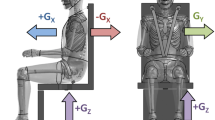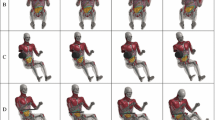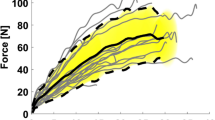Abstract
The use of human body models as an additional data point in the evaluation of human-machine interaction requires quantitative validation. In this study a validation of the Global Human Body Models Consortium (GHBMC) average male occupant model (M50-O v. 4.5) in a restrained frontal sled test environment is presented. For vehicle passengers, frontal crash remains the most common mode, and the most common source of fatalities. A total of 55-time history traces of reaction loads and kinematics from the model were evaluated against corresponding PMHS data (n = 5). Further, the model’s sensitivity to the belt path was studied by replicating two documented PMHS cases with prominent lateral and medial belt paths respectively. Results were quantitatively evaluated using open source CORA software. A tradeoff was observed; better correlation scores were achieved on gross measures (e.g. reaction loads), whereas better corridor scores were achieved on localized measures (rib deflections), indicating that subject specificity may dominate the comparison at localized anatomical regions. On an overall basis, the CORA scores were 0.68, 0.66 and 0.60 for force, body kinematics and chest wall kinematics. Belt force responses received the highest grouped CORA score of 0.85. Head and sternum kinematics earning a 0.8 and 0.7 score respectively. The model demonstrated high sensitivity to belt path, resulting in a 20-point increase in CORA score when the belt was routed closer to analogous location of data collection. The human model demonstrated overall reasonable biofidelity and sensitivity to countermeasures in frontal crash kinematics.



Similar content being viewed by others
References
Albert, D. L., S. M. Beeman, and A. R. Kemper. Occupant kinematics of the Hybrid III, THOR-M, and postmortem human surrogates under various restraint conditions in full-scale frontal sled tests. Traffic Inj. Prev. 19:S50–S58, 2018.
Arun M., J. Humm, N. Yoganandan and F. Pintar. Biofidelity Evaluation of a Restrained Whole Body Finite Element Model under Frontal Impact using Kinematics Data from PMHS Sled Tests In: IRCOBI. Lyon, France, 2015.
Ash J., D. Lessley, J. Forman, Q. Zhang, G. Shaw and J. R. Crandall. Whole Body Kinematics: Response Corridors for Restrained Frontal Impacts. In: IRCOBI Conference. Dublin, Ireland, 2012.
Ash, J., G. Shaw, D. Lessley, and J. R. Crandall. PMHS restraint and support surface forces in simulated frontal crashes. Int. J. Automot. Eng. 4:41–46, 2013.
Barker, J. B., D. S. Cronin, and R. W. Nightingale. Lower cervical spine motion segment computational model validation: kinematic and kinetic response for quasi-static and dynamic loading. J. Biomech. Eng. 139:16, 2017.
Bean, J. D., C. J. Kahane, M. Mynatt, R. W. Rudd, C. J. Rush, and C. Wiacek. Fatalities in Frontal Crashes Despite Seat Belts and Air Bags. Washington: National Highway Traffic Safety Administration, 2009.
Beck, L. F., A. M. Dellinger, and M. E. O’Neil. Motor vehicle crash injury rates by mode of travel, united states: using exposure-based methods to quantify differences. Am. J. Epidemiol. 166:212–218, 2007.
Beillas, P., and F. Berthet. An investigation of human body model morphing for the assessment of abdomen responses to impact against a population of test subjects. Traffic Inj Prev 18:S142–s147, 2017.
Brumbelow M. L. and D. S. Zuby. Impact and injury patterns in frontal crashes of vehicles with good ratings for frontal crash protection. In: 21st ESV Conference 2009.
Cavanaugh, J. M. The biomechanics of thoracic trauma. Accidental Injury, New York: Springer, 1993, pp. 362–390.
Crandall, J. R., D. Lessley, G. Shaw, and J. Ash. Displacement response of the spine in restrained PMHS during frontal impacts. Int. J. Automot. Eng. 5:59–64, 2014.
Davis, M. L., B. Koya, J. M. Schap, and F. S. Gayzik. Development and full body validation of a 5th percentile female finite element model. Stapp Car Crash J. 60:509–544, 2016.
DeWit, J. A., and D. S. Cronin. Cervical spine segment finite element model for traumatic injury prediction. J. Mech. Behav. Biomed. Mater. 10:138–150, 2012.
Fice, J. B., D. S. Cronin, and M. B. Panzer. Cervical spine model to predict capsular ligament response in rear impact. Ann. Biomed. Eng. 39:2152–2162, 2011.
Gayzik, F. S., I. P. Marcus, K. A. Danelson, J. D. Rupp, C. R. Bass, N. Yoganandan, and J. Zhang. A point-wise normalization method for development of biofidelity response corridors. J. Biomech. 48:4173–4177, 2015.
Gayzik, F., D. Moreno, K. Danelson, C. McNally, K. Klinich, and J. D. Stitzel. External landmark, body surface, and volume data of a mid-sized male in seated and standing postures. Ann. Biomed. Eng. 40:2019–2032, 2012.
Gayzik, F. S., D. M. Moreno, C. P. Geer, S. D. Wuertzer, R. S. Martin, and J. D. Stitzel. Development of a full body CAD dataset for computational modeling: a multi-modality approach. Ann. Biomed. Eng. 39:2568–2583, 2011.
Gehre C., H. Gades and P. Wernicke. Objective rating of signals using test and simulation responses. In: 21st International Technical Conference on the Enhanced Safety of Vehicles Conference (ESV), Stuttgart, Germany, 2009, pp. 15–18.
Guleyupoglu B., R. Barnard and F. S. Gayzik. Automating Regional Rib Fracture Evaluation in the GHBMC Detailed Average Seated Male Occupant Model. SAE Technical Paper, 2017.
Hayes, A. R. Geometric and Kinematic Validation Studies in the Thoracic and Abdominal Regions of a Detailed Human-Body Finite Element Model. Winston-Salem: Wake Forest University, 2013.
Hayes, A. R., N. A. Vavalle, D. P. Moreno, J. D. Stitzel, and F. S. Gayzik. Validation of simulated chestband data in frontal and lateral loading using a human body finite element model. Traffic Inj. Prev. 15:181–186, 2014.
Kim, Y. H., J. E. Kim, and A. W. Eberhardt. A new cortical thickness mapping method with application to an in vivo finite element model. Comput. Methods Biomech. Biomed. Eng. 17:997–1001, 2012.
Lee, E. L., M. Craig, and M. Scarboro. Real-world rib fracture patterns in frontal crashes in different restraint conditions. Traffic Inj. Prev. 16(Suppl 2):S115–123, 2015.
Lessley, D., G. Shaw, J. Ash, and J. R. Crandall. A Methodology for Assessing Intrasegmental Kinematics of the Whole Human Spine during Impacts. Int. J. Automot. Eng. 5:1–6, 2014.
Li, Z., M. W. Kindig, J. R. Kerrigan, C. D. Untaroiu, D. Subit, J. R. Crandall, and R. W. Kent. Rib fractures under anterior–posterior dynamic loads: experimental and finite-element study. J. Biomech. 43:228–234, 2010.
Li, Z., M. W. Kindig, D. Subit, and R. W. Kent. Influence of mesh density, cortical thickness and material properties on human rib fracture prediction. Med. Eng. Phys. 32:998–1008, 2010.
Maltese, M. R., R. H. Eppinger, H. H. Rhule, B. R. Donnelly, F. A. Pintar, and N. Yoganandan. Response corridors of human surrogates in lateral impacts. Stapp Car Crash J. 46:321–351, 2002.
Mao, H., L. Zhang, B. Jiang, V. V. Genthikatti, X. Jin, F. Zhu, R. Makwana, A. Gill, G. Jandir, and A. Singh. Development of a finite element human head model partially validated with thirty five experimental cases. J. Biomech. Eng. 135:111002, 2013.
Mattucci, S. F., J. A. Moulton, N. Chandrashekar, and D. S. Cronin. Strain rate dependent properties of younger human cervical spine ligaments. J. Mech. Behav. Biomed. Mater. 10:216–226, 2012.
Mattucci, S. F., J. A. Moulton, N. Chandrashekar, and D. S. Cronin. Strain rate dependent properties of human craniovertebral ligaments. J. Mech. Behav. Biomed. Mater. 23:71–79, 2013.
2016 Fatal motor vehicle crashes: Overview. edited by N. C. f. S. a. Analysis. Washington DC: National Highway Traffic Safety Administration, 2017.
Panjabi, M. M., J. J. Crisco, A. Vasavada, T. Oda, J. Cholewicki, K. Nibu, and E. Shin. Mechanical properties of the human cervical spine as shown by three-dimensional load–displacement curves. Spine 26:2692–2700, 2001.
Park G., T. Kim, J. R. Crandall, C. Arregui-Dalmases and J. Luzon-Narro. Comparison of Kinematics of GHBMC to PMHS on the Side Impact Condition. In: International Research Council on Biomechanics of Injury. Gothenburg, Sweden: 2013.
Pattimore, D., P. Thomas, and S. Dave. Torso injury patterns and mechanisms in car crashes: an additional diagnostic tool. Injury 23:123–126, 1992.
Pietsch, H. A., K. E. Bosch, D. R. Weyland, E. M. Spratley, K. A. Henderson, R. S. Salzar, T. A. Smith, B. M. Sagara, C. K. Demetropoulos, C. J. Dooley, and A. C. Merkle. Evaluation of WIAMan Technology Demonstrator Biofidelity Relative to Sub-Injurious PMHS Response in Simulated Under-body Blast Events. Stapp Car Crash J. 60:199–246, 2016.
Poulard, D., R. Kent, M. Kindig, Z. Li, and D. Subit. Thoracic response targets for a computational model: A hierarchical approach to asses the biofidelity of a 50th-percentile occupant male finite element model. J. Mech. Behav. Biomed. Mater. 45:45–64, 2015.
Poulard, D., D. Subit, B. Nie, J.-P. Donlon, and R. W. Kent. The contribution of pre-impact posture on restrained occupant finite element model response in frontal impact. Traffic Inj. Prev. 16:S87–S95, 2015.
Schoell, S. L., A. A. Weaver, J. E. Urban, D. A. Jones, J. D. Stitzel, E. Hwang, M. P. Reed, and J. D. Rupp. Development and validation of an older occupant finite element model of a mid-sized male for investigation of age-related injury risk. Stapp Car Crash J. 59:359, 2015.
Shaw, G., D. Parent, S. Purtsezov, D. Lessley, J. Crandall, R. Kent, H. Guillemot, S. A. Ridella, E. Takhounts, and P. Martin. Impact response of restrained PMHS in frontal sled tests: skeletal deformation patterns under seat belt loading. Stapp Car Crash J. 53:1, 2009.
Shi, X., L. Cao, M. P. Reed, J. D. Rupp, and J. Hu. Effects of obesity on occupant responses in frontal crashes: a simulation analysis using human body models. Comput. Methods Biomech. Biomed. Eng. 18:1280–1292, 2015.
Shin, J., and C. Untaroiu. Biomechanical and injury response of human foot and ankle under complex loading. J Biomech Eng 135:101008, 2013.
SAE. Instrumentation for Impact Test—Part 1—Electronic Instrumentation. J211/1, Warrendale, PA: Society of Automotive Engineers Test Instrumentation Standards Committee, 1995.
SAE. Sign convention for vehicle crash testing. J1733, Warrendale, PA: Society of Automotive Engineers Test Instrumentation Standards Committee, 1995.
Soni, A., and P. Beillas. Modelling hollow organs for impact conditions: a simplified case study. Comput. Methods Biomech. Biomed. Eng. 18:730–739, 2013.
Takhounts, E. G., M. J. Craig, K. Moorhouse, J. McFadden, and V. Hasija. Development of brain injury criteria (Br IC). Stapp Car Crash J. 57:243–266, 2013.
Untaroiu, C. D., N. Yue, and J. Shin. A finite element model of the lower limb for simulating automotive impacts. Ann. Biomed. Eng. 41:513–526, 2013.
Vavalle, N. A., M. L. Davis, J. D. Stitzel, and F. S. Gayzik. Quantitative validation of a human body finite element model using rigid body impacts. Ann. Biomed. Eng. 43:2163–2174, 2015.
Vavalle, N. A., B. C. Jelen, D. P. Moreno, J. D. Stitzel, and F. S. Gayzik. An evaluation of objective rating methods for full-body finite element model comparison to PMHS tests. Traffic Inj. Prev. 14:S87–S94, 2013.
Vavalle N., D. Moreno, A. Rhyne, J. Stitzel and F. Gayzik. The validation of a full body finite element model in lateral full body sled and drop tests. In: VT-WFU School of Biomedical Engineering and Sciences Symposium, Winston-Salem, NC, 2012.
Vavalle, N. A., D. P. Moreno, A. C. Rhyne, J. D. Stitzel, and F. S. Gayzik. Lateral impact validation of a geometrically accurate full body finite element model for blunt injury prediction. Ann. Biomed. Eng. 41:497–512, 2013.
Vavalle, N. A., A. B. Thompson, A. R. Hayes, D. P. Moreno, J. D. Stitzel, and F. S. Gayzik. Investigation of the mass distribution of a detailed seated male finite element model. J. Appl. Biomech. 30:471–476, 2014.
World Health Organization. Global Status Report on Road Safety. Geneva: World Health Organization, 2015.
Yanaoka T. and Y. Dokko. A Parametric Study of Age-Related Factors Affecting Intracranial Responses under Impact Loading Using a Human Head/Brain FE Model. In: International Research Council on Biomechanics Injury (IRCOBI). Gothenburg, Sweeden: 2013.
Yue N., J. Shin and C. Untaroiu. Development and validation of an occupant lower limb finite element model. In: SAE Technical Paper, 2011.
Yue, N., and C. D. Untaroiu. A numerical investigation on the variation in hip injury tolerance with occupant posture during frontal collisions. Traffic Inj. Prev. 15:513–522, 2014.
Acknowledgments
This work was supported by the Global Human Body Models Consortium, LLC, under GHBMC Project No. WFU-006. All simulations were run on the DEAC cluster at Wake Forest University, with support provided by Adam Carlson and Cody Stevens. The authors gratefully acknowledge the contributions of GHBMC developers, including: L. Zhang (Wayne State), D. Cronin (U. Waterloo), M. Panzer (U. Virginia), P. Beillas (U. Lyon). Dale Johnson (WFU) assisted in manuscript preparation.
Conflict of interest
F Scott Gayzik is a member of Elemance, LLC., which distributes academic and commercial licenses for the use of GHBMC-owned computational human body models.
Author information
Authors and Affiliations
Corresponding author
Additional information
Associate Editor Estefanía Peña oversaw the review of this article.
Electronic supplementary material
Below is the link to the electronic supplementary material.
Rights and permissions
About this article
Cite this article
Schap, J.M., Koya, B. & Gayzik, F.S. Objective Evaluation of Whole Body Kinematics in a Simulated, Restrained Frontal Impact. Ann Biomed Eng 47, 512–523 (2019). https://doi.org/10.1007/s10439-018-02180-2
Received:
Accepted:
Published:
Issue Date:
DOI: https://doi.org/10.1007/s10439-018-02180-2




